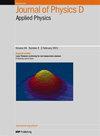Review of lead-free Bi-based dielectric ceramics for energy-storage applications
IF 3.2
3区 物理与天体物理
Q2 PHYSICS, APPLIED
引用次数: 36
Abstract
Dielectric energy-storage ceramics have the advantages of high power density and fast charge and discharge rates, and are considered to be excellent candidate materials for pulsed power-storage capacitors. At present, the application of dielectric energy-storage ceramics is hindered by their low energy density and the fact that most of them contain elemental lead. Therefore, lead-free dielectric energy-storage ceramics with high energy storage density have become a research hot spot. In this paper, we first present the requirements that dielectric energy-storage capacitors impose on the properties of ceramic materials. We then review our previous research work combined with research progress into bismuth (Bi)-based lead-free energy-storage ceramics including Bi0.5Na0.5TiO3 (BNT), BiFeO3, and Bi0.2Sr0.7TiO3, in which the composition design ideas and related energy-storage characteristics of BNT-based lead-free energy-storage ceramics are emphasized. At the same time, we highlight the problems faced by Bi-based lead-free energy-storage ceramics and some strategies for addressing them. Finally, we examine the future prospects of research into Bi-based lead-free energy-storage ceramics.无铅铋基介电陶瓷储能研究进展
介质储能陶瓷具有功率密度高、充放电速率快等优点,是制备脉冲储能电容器的理想材料。目前,介电储能陶瓷的能量密度低,且大多含有元素铅,阻碍了其应用。因此,具有高储能密度的无铅介质储能陶瓷成为研究热点。本文首先介绍了电介质储能电容器对陶瓷材料性能的要求。结合Bi0.5Na0.5TiO3 (BNT)、BiFeO3、Bi0.2Sr0.7TiO3等铋(Bi)基无铅储能陶瓷的研究进展,综述了前人的研究工作,重点介绍了铋(Bi)基无铅储能陶瓷的组成设计思路和相关的储能特性。同时,我们也强调了铋基无铅储能陶瓷所面临的问题以及解决这些问题的策略。最后,展望了铋基无铅储能陶瓷的研究前景。
本文章由计算机程序翻译,如有差异,请以英文原文为准。
求助全文
约1分钟内获得全文
求助全文
来源期刊
CiteScore
6.80
自引率
8.80%
发文量
835
审稿时长
2.1 months
期刊介绍:
This journal is concerned with all aspects of applied physics research, from biophysics, magnetism, plasmas and semiconductors to the structure and properties of matter.

 求助内容:
求助内容: 应助结果提醒方式:
应助结果提醒方式:


